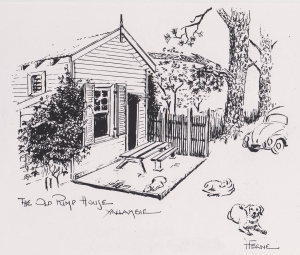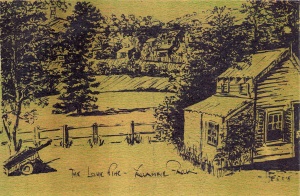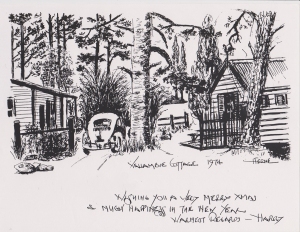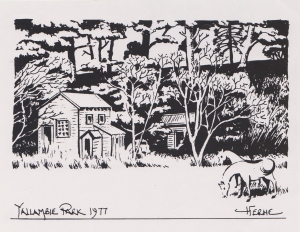He was known locally as “Old Harry” and in the conservative pre-Whitlam era ’60s, Old Harry Ferne was something of a Yallambie eccentric. The stories that surrounded Harry were legendary and as he assured his listeners, they were all true. Well, mostly. A square peg in a round hole. You might say that they broke the mould when they made Old Harry.

Harry Ferne lived in a one room cottage on the banks of the Plenty River. He was a relative or maybe a sometime friend of the Temby family at Yallambie Homestead. Nobody was really quite sure exactly. He moved into a cottage in the garden on the river flat below the Homestead in 1968 and stayed there for more than a decade, even in the face of increasing pressure from Heidelberg City Council to move him out. In a recorded interview made in the early 1980s Harry remembered that, “When I arrived in the area there was a forest of trees. Now there’s a forest of houses.” (Heidelberger, 2 June, 1982)

Like a hermit at the bottom of the garden in the finest of English folly traditions, Old Harry was a bit of an enigma. He walked with a pronounced stoop that belied his clipped moustache and a somewhat understated military bearing. A “real gentleman” as one local described him but a man who was for all that, prepared to live outside of the mores of society. Local children from the nearby developing housing estate seemed drawn to him and “descended on him in droves, keen to fish for tadpoles in his water storage ponds,” or to simply spend time with this curious character with the mysterious past. In an era when children could spend as much time as they wanted with an older, unmarried man living alone in peculiar and reduced circumstances without anyone batting an eyelid, Old Harry and his stories became a magnet for juvenile gangs, the king of the kids in the Yallambie area.

Harry’s Yallambie Cottage was a single roomed timber dwelling that had been built at the foot of the Yallambie escarpment sometime in the dim dark, far distant past, nobody could quite remember when. Maybe it was a re-erection of a Bakewell pre-fab, but who knows. Harry said, “When I took over the cottage, it was a ruin. No windows, no door, no water and no sewerage. Just possums in the roof, bees in two walls and a wombat under the floorboards.”
Harry set to work and cleaned up the ramshackle building, laying brick paving and redeveloping the remnant gardens surrounding the exterior.

Harry was fascinated by the history of the area and especially the legend that Baron Ferdinand von Mueller had contributed to the Yallambie landscape. He would point out trees to interested listeners as possible contenders for a von Mueller provenance. Even in 1970 these trees were well over 100 years old and on one occasion Harry narrowly escaped with his life when a pair of trees from the Yallambie pinetum collapsed and nearly destroyed his house.

The Yallambie Cottage was surrounded by a forest of these exotic trees and in the winter months the smoke from Harry’s fires hung low, trapped by their overhanging branches. Harry did a lot of his cooking on a barbecue in a half barrel outside but his cottage also housed a cast iron range where he made toast and where an old kettle was kept continuously on the boil for anybody who cared to stop by long enough to share a yarn and a strong cup of tea.
Harry’s cottage neighboured the nearby old Yallambie pumping house which in the farming era had been used to draw water up from the river for use in the outlying paddocks. Invoking the principle that possession remains nine tenths of the law, Harry claimed the pumping house likewise as his own, although ostensibly it was located on Heidelberg City Council land. This was Harry’s world. It was a place to spend time with friends both young and old. It was a place to watch the passing of the seasons and to stare at the reflections in the waters of the river. And it was a place to think about the past.
Harry’s was a naturally artistic nature and he spent hours in the fields sketching the surrounding river landscape. He was a friend of the Dutch sculptor Rein Slagmolen whose artists’ colony at the nearby former convent, Casa Maria, was an early feature of the pre subdivisional landscape of Yallambie. Harry also had friends in the theatre and the opera who probably wondered at what they had struck when they came to visit him in his rural realm.


Harry kept a car, an early model VW Beetle, but it didn’t get driven about much. Harry didn’t find much need to get behind the wheel or to leave the area. The Temby children and others kept their horses on the Yallambie river flats and it was the horses that Harry preferred to populate his drawings with.

Harry kept an old concrete water trough near the cottage for the horses but when one enterprising young lad used Harry’s water colour paints to paint the trough an ultramarine blue, Harry was less than impressed.
In the summer months Harry harvested the fruit from the Yallambie orchards and in those days, there were many more trees than the few that remain today into the 21st millennium.

Pears, apples, loquats, figs, grapes and walnuts grew on the river flats in abundance but Harry also added to his crop by collecting baskets of blackberries from the vines that grew out of control along the river. Harry was a surprisingly good cook and the produce was baked into apple and blackberry pies and shared around the neighbourhood with friends and acquaintances. Throw in the occasional snared rabbit and Old Harry was virtually living off the land at Yallambie. “We’re 10 miles from the city, yet you would think we were 100 miles away,” he said. Every year on the 5th November a great bonfire would be kindled on the flats marking Guy Fawkes’ treasonous plot and “cracker night” would be celebrated with a great deal of noise and potatoes roasted in the embers of the fire.
There was no bath or shower in the Yallambie cottage and Harry’s ablutions were limited to a regular swim in the river. Toiletry arrangements involved a septic tank which Harry installed himself alongside the cottage but herein were sown the seeds to the eventual demise of his riverside rural idyll.
The cottage stood on the Plenty River flood plain. Three times in the 1970s Harry was flooded out and on one occasion he battled a surge of water that came up to his chest inside the house. Harry dug a deep 100 foot trench to the river and carted 10 tons of white sand onto the river flats to shore up the property and to protect it from flooding, but it was to no avail. The Melbourne and Metropolitan Board of Works wanted Harry gone, reasoning that every time the river flooded there was of a risk of Harry’s septic getting into the stream. In 1978 the matter went all the way to the Housing Commission and The Honourable Geoff Hayes, the State Minister of Housing.

In the face of this Harry finally resolved to buy a block of land in Tarcoola Drive bordering the derelict Yallambie Homestead stables. He paid about $5000 for his block and designed and built a home, putting many of his own details into the construction of the interior, everything from the blue slate floor to the leadlight chimney window, (courtesy of his friendship with Rein Slagmolen). It was a far cry from the Yallambie Cottage but Harry didn’t stop there, carving a garden into the steep slope at the back of his Tarcoola Drive address, slashing blackberries and replacing them with clusters of pampas grass and a jungle of ferns. Hundreds of blue stone blocks were introduced into the landscape with Harry erecting a flying fox rope pulley to man handle the rocks down the slope and into position. Brick paving and ponds were designed to create a Japanese style feel to the garden.

Harry said, “I love the feeling of rocks and water. I want to achieve a harmony between man and nature. I don’t think I’ll ever actually finish the garden. It’s an ongoing evolutionary process.”

He never did finish. Time had moved on and “Old Harry” was now approaching an age befitting his moniker. Soon after moving into his new home, vandals burned the pumping house and the cottage to the ground on the river flats.
Harry said, “I don’t think I’ll ever shift out of Yallambie. It all depends whether I get married or not.”
The garden Harry built in Tarcoola Drive is now a ruin, his cottage and the pumping house little more than memory. The sobriquet “Harry’s” on a letter box of a house now the only pointer to the identity of its original owner.
Harry didn’t marry of course. He died 30 years ago from a coronary occlusion while on the Heidelberg Golf Course, proof if proof be needed that if you’ve gotta go, better to go while doing something you love.

But for all that there are some who still think that Harry was true to his word. At the setting of the sun as the shadows lengthen under the trees on the river escarpment, there is a very real feeling that maybe Harry never left Yallambie after all. It is a belief held by the current owner and visitors to the Tarcoola Drive house that Harry built. At the closing of the day, the spirit of Old Harry lives on.



Great read Ian! Love reading about Yallambies history !
LikeLike
Absolutely wonderful work Ian. I am enthralled. What a massive amount of research you have done.
Many thanks also for mention of Casa Maria. I well remember the nuns waiting on the corner of Yallambie and Greensborough Roads in the 1950s for a bus. I, the little protestant, was terrified of them in their black rigouts.
Despite this memory, as I’ve been feasting on these blogs I had begun to wonder if the nunery at the bottom of Yallambie Road was somehow a figurement of my imagination. But now I’m reassured that it really was there!
LikeLike
Hi Ian, i’ve stumbled across your site today, after hearing about Viewbank Homestead on the ABC.
I grew up in Yallambie from the mid 70’s, and now live near Banyule homestead in Heidelberg, and have many fond memories of Old Harry’s place. It was the meeting place for us kids to hang around at, and a secret place to try the first ciggie, or wag from school.
Thanks for providing such a rich history of Harry.
Merrill
LikeLike
Hi Merrill, great to hear from somebody who was here in those days and remembers some of these stories. A tumbled down chimney and brick paving buried in the undergrowth at the foot of the escarpment is all that remains now of Harry’s cottage. Ian
LikeLike
Thank you for this wonderful article on Old Harry. I grew up in Yallambie in Bimbadeen Cres. Our house was one of the earlier homes and I had a childhood of playing on all the construction sites. We were those people who kept their horses on the river flats and I spent most of my hours running about the fields, collecting tadpoles and generally being a wild kid. I remember Old Harry chasing us off the land, no doubt we were total pests. I always wondered what had come of him. Thank you for answering all my questions.
LikeLike
Thanks for the comment Jackie and for sharing those memories. Ian
LikeLike